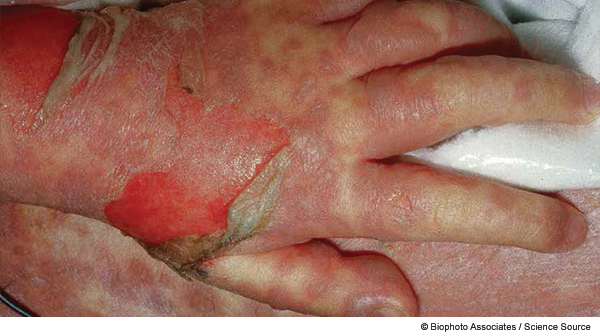
Shortly after transfer to the pediatric ICU, the patient’s respiratory status worsens. He is taken to the operating room with ENT and anesthesia for elective intubation for airway protection. Upper airway evaluation shows desquamation of the supraglottic structures without tracheal involvement. The patient is diagnosed with TEN secondary to mycoplasma infection based on positive immunoglobulin G and immunoglobulin M titers. The patient receives a three-day course of IVIG empirically. Ophthalmologic evaluation confirms a left corneal abrasion and extensive ocular involvement, also consistent with TEN. Four days into the hospital stay, the patient has a cardiac arrest. The suspected culprit is a mucous plug in the endotracheal tube. He subsequently has bilateral chest tubes placed for pneumothoraces. Throughout his hospital stay, he has several episodes of fever and is on acyclovir, azithromycin, vancomycin, and cefotaxime at varying points.
Explore This Issue
ACEP Now: Vol 34 – No 02 – February 2015The patient is discharged after a four-week hospital stay to a pediatric rehabilitation facility. Ophthalmologic, dermal, and respiratory findings have all resolved, and the patient is back to playing video games and attending kindergarten, as he did prior to the acute illness.
Dr. Kosoko is a postdoctoral fellow in pediatric emergency medicine and global health at Baylor College of Medicine/Texas Children’s Hospital. She practices adult and pediatric emergency medicine in Houston and can be reached at aakosoko@texaschildrens.org.
Dr. Kaziny is an assistant professor of pediatrics in the section of emergency medicine at Baylor College of Medicine. He practices pediatric emergency medicine at Texas Children’s Hospital.
References
- Abood GJ, Nickoloff BJ, Gamelli RL. Treatment strategies in toxic epidermal necrolysis syndrome: where are we at? J Burn Care Res. 2008;29:269-276.
- Bastuji-Garin S, Rzany B, Stern RS, et al. Clinical classification of cases of toxic epidermal necrolysis, Stevens-Johnson syndrome, and erythema multiforme. Arch Dermatol. 1993;129:92-96.
- Spies M, Sanford AP, Aili Low JF, et al. Treatment of extensive toxic epidermal necrolysis in children. Pediatrics. 2001;108:1162-1168.
- Roujeau JC, Kelly JP, Naldi L, et al. Medication use and the risk of Stevens-Johnson syndrome or toxic epidermal necrolysis. N Engl J Med. 1995;333:1600-1607.
- Endorf FW, Cancio LC, Gibran NS. Toxic epidermal necrolysis clinical guidelines. J Burn Care Res. 2008;29:706-712.
- Ferrandiz-Pulido C, Garcia-Patos V. A review of causes of Stevens-Johnson syndrome and toxic epidermal necrolysis in children. Arch Dis Child. 2013;98:998-1003.
Pages: 1 2 3 4 | Single Page





No Responses to “Recognize Pediatric Toxic Epidermal Necrolysis Symptoms, Manage Disease”